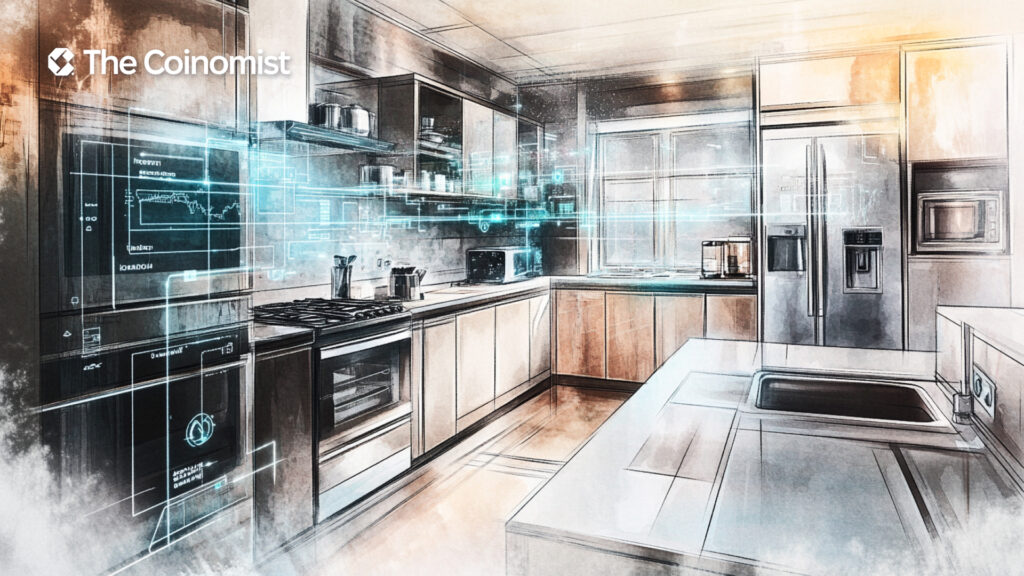The Distant Future Is Here: Smart Homes Powered by Blockchain

Smart homes continue to evolve as blockchain and the Internet of Things (IoT) reshape modern living, making homes more secure and self-sufficient. Learn how these systems differ from earlier versions and explore real-world use cases.
On this page
In the early 2010s, smart homes felt like a dream for tech geeks:
- Lights turning on with a clap
- Heating systems starting at scheduled times
- Refrigerators reminding you to restock groceries
- Smart curtains and more
These were the first steps toward home automation. But unfortunately, they lacked structure. Different companies controlled systems through their own centralized servers, and user behavior data often ended up in the hands of advertisers or hackers.
Today, the situation looks very different.
Blockchain, a digital ledger distributed across thousands of independent nodes, securely stores records and their full history. And when combined with the Internet of Things (IoT), a network of home devices that communicate over the internet, it helps create a new kind of home.
These homes aren’t just “smart.” They’re autonomous, secure, and capable of operating without any intermediaries.
So how does this work in practice, and which of these ideas already exist in the real world?

How Blockchain and IoT Are Transforming Homes
Today’s smart homes go far beyond basic automation. Blockchain and IoT work together to create secure, fully autonomous systems.
- Blockchain brings a level of security that earlier smart home setups couldn’t offer. Every action, whether it’s switching on a light or unlocking a door, gets recorded in an encrypted chain of data. Tampering with it is nearly impossible because any change would require rewriting the entire transaction history across the network, which can only be validated through algorithmic consensus.
- IoT sensors keep track of everything happening in the home, sending real-time activity and status updates directly to the blockchain. This setup prevents outsiders from interfering with the system. Unlike traditional security services that rely on centralized servers, these homes avoid having a single point of failure.
Resource efficiency is also reaching a new level. IoT devices track energy consumption, while blockchain processes the data and helps optimize the home’s performance. Meanwhile, homeowners can send payments for utilities directly to providers using cryptocurrency, without going through banks.
This setup cuts out intermediaries and lowers costs—something older systems, which rely on property management companies, couldn’t offer.
Related: Smart Home Devices in 2024: Are They Worth the Hype?
Real-World Smart Homes on Blockchain
Smart home development has already moved from theory to practice. Researchers and companies are building systems that show how the technology works in everyday settings.
Here are a few specific examples, supported by research and real project data.
IBM’s Smart Home on Blockchain
Early development of blockchain-powered smart homes began with lab testing of prototypes. A study published in Computers & Electrical Engineering describes a system where temperature and lighting IoT sensors connect through blockchain.
The sensors collect climate data, such as temperature and humidity, from different rooms. The blockchain logs this information, allowing the home to adjust conditions automatically. Moreover, tests in small buildings showed that the system worked consistently without needing human supervision. These results confirm that basic smart home functions already work in practice.
One clear example is IBM’s SmartHome Blockchain project. In 2020, the company introduced a system that used a private Hyperledger blockchain to manage IoT devices like smart thermometers, outlets, and locks. Homeowners could grant guests access using temporary digital keys, and the system recorded all activity on the blockchain. The project showed how blockchain can improve security compared to older systems that rely on centralized servers (a common weak point in earlier setups).
Related: Samsung Integrates Blockchain in AI Home Devices
Energy Management by Fujitsu and Hdac
Major companies are also actively involved in developing these technologies.
This startup uses blockchain and artificial intelligence to streamline real estate management, including smart homes. In 2021, Propy launched a platform where IoT devices track rental details, such as check-in and check-out times, while blockchain confirms payments made in cryptocurrency. For example, one house in California already runs on this system. Tenants pay rent using Ethereum, and IoT-enabled locks grant access once the transaction goes through. This approach moves the industry closer to fully autonomous home rental and management.
In 2020, the Japanese company tested a smart home system where IoT energy meters connected with blockchain technology to allow neighbors to share surplus electricity. The system recorded each transaction, making the process fully transparent. While it was a pilot, it showed how homes can function as part of an energy network—something earlier systems from ten years ago didn’t offer.
The Swiss company has also made progress in this field. In 2019, Hdac launched a platform that connects IoT devices (lighting and climate control systems) to a private blockchain for home management. During a pilot project, residents used a mobile app to control their energy and heating usage, while a decentralized network secured all the data. This approach helped reduce maintenance costs and improved reliability compared to older centralized systems.

These projects prove that blockchain and IoT sensors can work together to build systems that are fully automated and resistant to failures. Unlike older smart home models, these systems use decentralized control, which makes them more flexible and secure.
Related: Google Unveils AI-Powered Thermostat
The Future of Smart Homes on Blockchain
Smart homes that use IoT technology represent just the starting point. As innovation continues, what seems experimental today could become standard tomorrow.
So where is this heading?
Researchers believe that these systems will grow beyond individual homes. In the future, entire neighborhoods could run on blockchain, using IoT networks to share energy or water. For example, solar panels on one house could send extra energy to a neighbor, while blockchain handles the fair calculation. This approach moves cities closer to a future where resources get distributed more efficiently, with less waste.
Autonomous blockchains offer clear advantages for implementing large-scale projects:
- Dynamic device management
Unlike centralized IoT systems, a decentralized blockchain-based architecture allows for real-time, flexible control of devices. This reduces downtime and improves operational efficiency in smart cities.
- Unified control across a distributed network
IoT devices connected to smart home networks can coordinate through a single blockchain, making it easier to scale the system for large urban projects.
- Transparency and security
Combining public and private blockchains creates a reliable and open environment where data stays protected and all participants can clearly understand how the system works.
- Ease of use for limited-capability devices
Real-time access control improves the functionality and convenience of even basic IoT devices, making them more user-friendly for residents of smart cities.
However, to make this technology widely accessible, developers need to create and apply unified standards so that devices from different manufacturers can work together smoothly. One potential solution involves using Decentralized Wireless (DeWi) infrastructure.
Find more details on this technology in our article: “What Is Decentralized Wireless (DeWi) and How It Works.”
Another challenge for a smart home on blockchain is energy consumption. Managing large volumes of data across a decentralized network takes a lot of resources. As a result, this demand could cancel out many of the energy-saving benefits for the end user.
Still, developers are actively working on this issue, and each new smart home prototype reduces maintenance costs.
The content on The Coinomist is for informational purposes only and should not be interpreted as financial advice. While we strive to provide accurate and up-to-date information, we do not guarantee the accuracy, completeness, or reliability of any content. Neither we accept liability for any errors or omissions in the information provided or for any financial losses incurred as a result of relying on this information. Actions based on this content are at your own risk. Always do your own research and consult a professional. See our Terms, Privacy Policy, and Disclaimers for more details.

























